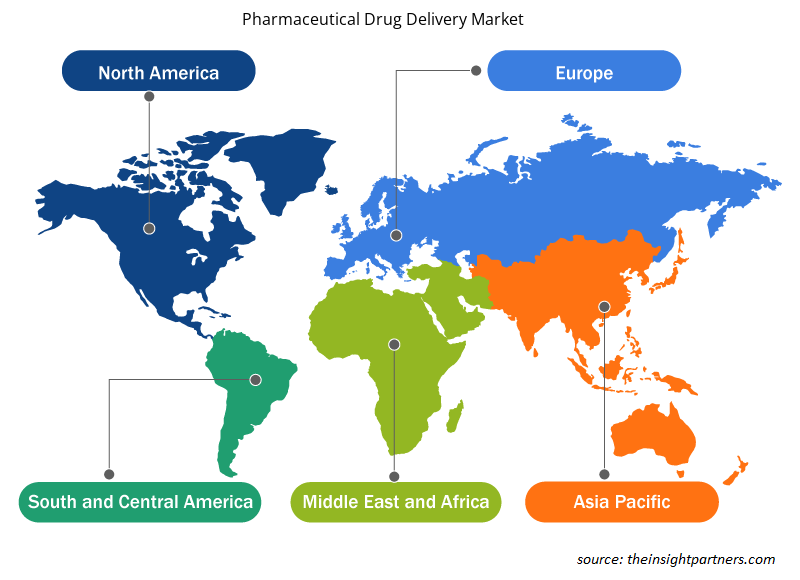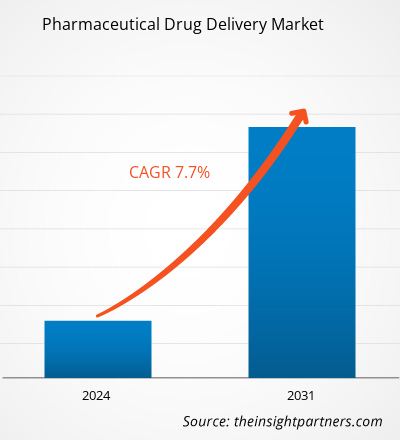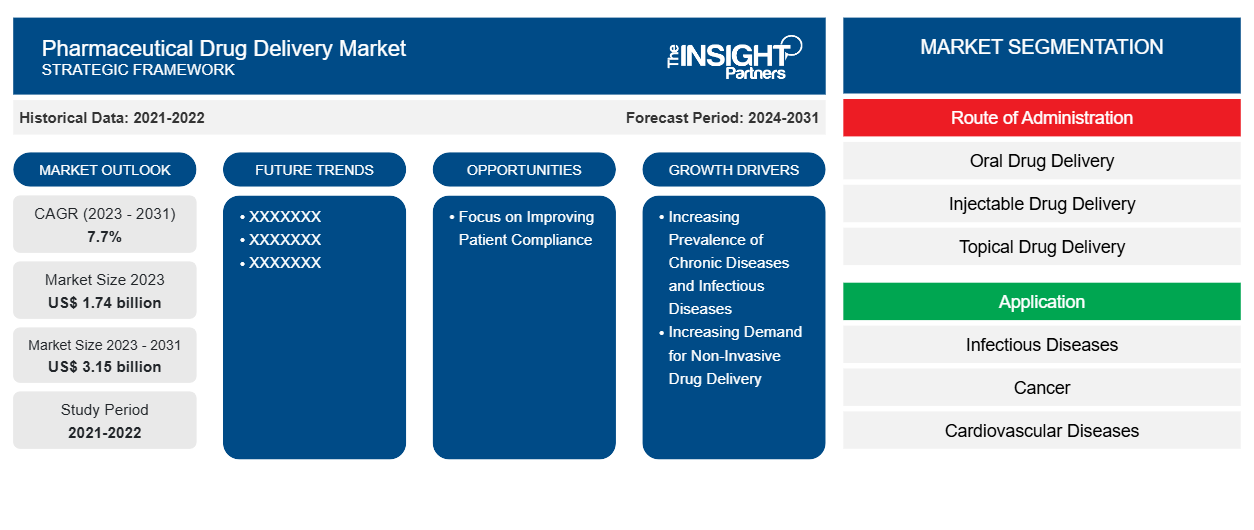La taille du marché de l'administration de médicaments pharmaceutiques a été estimée à 1,74 milliard USD en 2023 et devrait atteindre 3,15 milliards USD d'ici 2031 ; elle devrait enregistrer un TCAC de 7,7 % jusqu'en 2031. Les développements stratégiques et les lancements de produits devraient rester les principales tendances du marché de l'administration de médicaments pharmaceutiques.
Analyse du marché de l'administration de médicaments pharmaceutiques
L'augmentation de la population gériatrique, l'augmentation des soins à domicile, la prévalence croissante des maladies chroniques, l'augmentation des interventions chirurgicales et la prévalence croissante des maladies infectieuses stimulent la croissance du marché de l'administration de médicaments pharmaceutiques. En outre, l'augmentation du nombre d'approbations par la FDA de divers dispositifs d'administration de médicaments non invasifs et l'augmentation des dépenses de recherche et développement des sociétés pharmaceutiques pour le développement de médicaments ont stimulé la demande d'administration de médicaments pharmaceutiques.
Aperçu du marché de l'administration de médicaments pharmaceutiques
Les systèmes d'administration de médicaments sont principalement utilisés pour l'administration contrôlée ou ciblée de divers agents thérapeutiques afin de traiter diverses maladies ou d'améliorer la santé des patients. La Chine est l'un des principaux marchés émergents sur le marché de l'administration de médicaments pharmaceutiques. Le marché chinois des dispositifs d'administration de médicaments est stimulé par les avancées technologiques de l'industrie des dispositifs médicaux et par l'intérêt croissant porté au diagnostic et au traitement des maladies chroniques chez les adultes et les personnes âgées. La Chine devrait offrir des opportunités lucratives aux acteurs locaux et internationaux pour fabriquer et commercialiser des dispositifs d'administration de médicaments dans le pays au cours de la période de prévision.
Personnalisez ce rapport en fonction de vos besoins
Vous bénéficierez d'une personnalisation gratuite de n'importe quel rapport, y compris de certaines parties de ce rapport, d'une analyse au niveau des pays, d'un pack de données Excel, ainsi que de superbes offres et réductions pour les start-ups et les universités.
-
Obtenez les principales tendances clés du marché de ce rapport.Cet échantillon GRATUIT comprendra une analyse de données, allant des tendances du marché aux estimations et prévisions.
Facteurs moteurs et opportunités du marché de l'administration de médicaments pharmaceutiques
Demande croissante en matière d'administration non invasive de médicaments
L'administration non invasive de médicaments implique généralement des méthodes d'administration indolore de médicaments à travers les barrières biologiques des surfaces muqueuses ou de la peau. Cette méthode d'administration de médicaments pourrait conduire à un meilleur accès aux médicaments, à des profils de sécurité des médicaments améliorés et à l'adhésion aux régimes de traitement. Les patients préfèrent les voies d'administration de médicaments non invasives en raison des avantages par rapport à l'administration de médicaments par injection, tels que l'absence de blessures et d'infections dues aux aiguilles et la rentabilité des voies d'administration non invasives. Quelques-unes des méthodes d'administration de médicaments non invasives les plus populaires sont : topique, transdermique passive, transdermique active (pénétration améliorée assistée par dispositif), membrane transmuqueuse, membrane transoculaire et administration via une membrane alvéolaire à partir de médicaments inhalés. L'administration de médicaments à l'aide de méthodes non invasives implique une fréquence de dosage réduite et des schémas posologiques simplifiés. De plus, ces systèmes d'administration peuvent réduire considérablement le coût de l'utilisation clinique car les patients peuvent s'auto-administrer les médicaments via ces méthodes. Ainsi, la demande croissante de systèmes d'administration de médicaments non invasifs propulse la croissance du marché des systèmes d'administration de médicaments.
Mettre l’accent sur l’amélioration de la conformité des patients – une opportunité pour le marché de la distribution de médicaments pharmaceutiques
Le faible taux d'observance du traitement par les patients est une préoccupation majeure des médecins et des fabricants de dispositifs médicaux. Par conséquent, les fabricants se concentrent sur le développement de systèmes d'administration de médicaments intuitifs et conviviaux qui offrent un confort élevé aux patients. Les patients, les soignants et les médecins recherchent des solutions plus centrées sur le patient, évaluant les systèmes d'administration et les options d'emballage pour encourager les patients à prendre leurs médicaments comme indiqué. Des doses mesurées avec précision et un emballage facile à utiliser avec un étiquetage clair sont essentiels pour répondre aux besoins d'autosuffisance d'aujourd'hui. Un emballage ou un récipient à dose unitaire est rempli avec précision pour contenir des médicaments dans des quantités prévues pour une seule dose. Ces caractéristiques réduisent les erreurs de médication car l'identité d'un médicament est rapidement confirmée et l'emballage garantit que les patients prennent la bonne dose de médicaments. Les fabricants de médicaments se concentrent désormais sur des systèmes d'administration de médicaments qui offrent une facilité d'utilisation, une portabilité et une commodité pour les patients qui prennent des médicaments ailleurs qu'à leur domicile. Il a été constaté que l'observance du traitement par les patients est beaucoup plus élevée lorsque les médicaments sont administrés par des méthodes non invasives, car ils ressentent moins de douleur pendant la procédure.
Analyse de segmentation du rapport sur le marché de la distribution de médicaments pharmaceutiques
Les segments clés qui ont contribué à l’élaboration de l’analyse du marché de l’administration de médicaments pharmaceutiques sont la voie d’administration, l’application et l’utilisateur final.
- En fonction de la voie d'administration, le marché de l'administration de médicaments pharmaceutiques est segmenté en administration de médicaments par voie orale, administration de médicaments par voie injectable, administration de médicaments par voie topique, administration de médicaments par voie oculaire, administration de médicaments par voie pulmonaire, administration de médicaments par voie nasale, administration de médicaments par voie transmuqueuse et administration de médicaments implantables. Le segment de l'administration de médicaments injectables détenait la plus grande part de marché en 2023.
- Par application, le marché de l'administration de médicaments pharmaceutiques est segmenté en maladies infectieuses, cancer, maladies cardiovasculaires, diabète, maladies respiratoires, troubles du système nerveux central, maladies auto-immunes et autres. Le segment du cancer détenait la plus grande part de marché en 2023.
- En fonction de l'utilisateur final, le marché de l'administration de médicaments pharmaceutiques est segmenté en hôpitaux, établissements de soins à domicile, centres de soins de santé et cliniques, entre autres. Le segment des hôpitaux détenait la plus grande part de marché en 2023.
Analyse des parts de marché des services de distribution de médicaments pharmaceutiques par zone géographique
La portée géographique du rapport sur le marché de l’administration de médicaments pharmaceutiques est principalement divisée en cinq régions : Amérique du Nord, Asie-Pacifique, Europe, Moyen-Orient et Afrique, et Amérique du Sud et centrale.
L'Amérique du Nord domine le marché de l'administration de médicaments pharmaceutiques. La croissance du marché en Amérique du Nord est caractérisée par une demande accrue de médicaments contre les maladies infectieuses de la part des patients, la présence d'acteurs clés du marché, une augmentation des lancements de produits, une prévalence croissante des maladies chroniques et une R&D approfondie menée par les instituts universitaires et de recherche et les laboratoires pharmaceutiques. Grâce aux progrès technologiques, les thérapies par perfusion peuvent être gérées de manière sûre et efficace à domicile. La thérapie par perfusion dans les établissements de soins à domicile est devenue une thérapie totalement rentable et a donné lieu à la création d'un traitement en milieu hospitalier ou d'un établissement de soins infirmiers spécialisés, stimulant ainsi la croissance du marché de l'administration de médicaments en Amérique du Nord. De plus, l'Asie-Pacifique devrait enregistrer le TCAC le plus élevé dans les années à venir.
Aperçu régional du marché de la distribution de médicaments pharmaceutiques
Les tendances et facteurs régionaux influençant le marché de l’administration de médicaments pharmaceutiques tout au long de la période de prévision ont été expliqués en détail par les analystes d’Insight Partners. Cette section traite également des segments et de la géographie du marché de l’administration de médicaments pharmaceutiques en Amérique du Nord, en Europe, en Asie-Pacifique, au Moyen-Orient et en Afrique, ainsi qu’en Amérique du Sud et en Amérique centrale.

- Obtenez les données régionales spécifiques au marché de la distribution de médicaments pharmaceutiques
Portée du rapport sur le marché de l'administration de médicaments pharmaceutiques
| Attribut de rapport | Détails |
|---|---|
| Taille du marché en 2023 | 1,74 milliard de dollars américains |
| Taille du marché d'ici 2031 | 3,15 milliards de dollars américains |
| Taux de croissance annuel composé mondial (2023-2031) | 7,7% |
| Données historiques | 2021-2022 |
| Période de prévision | 2024-2031 |
| Segments couverts |
Par voie d'administration
|
| Régions et pays couverts |
Amérique du Nord
|
| Leaders du marché et profils d'entreprises clés |
|
Densité des acteurs du marché de la distribution de médicaments pharmaceutiques : comprendre son impact sur la dynamique commerciale
Le marché de la distribution de médicaments pharmaceutiques connaît une croissance rapide, tirée par la demande croissante des utilisateurs finaux en raison de facteurs tels que l'évolution des préférences des consommateurs, les avancées technologiques et une plus grande sensibilisation aux avantages du produit. À mesure que la demande augmente, les entreprises élargissent leurs offres, innovent pour répondre aux besoins des consommateurs et capitalisent sur les tendances émergentes, ce qui alimente davantage la croissance du marché.
La densité des acteurs du marché fait référence à la répartition des entreprises ou des sociétés opérant sur un marché ou un secteur particulier. Elle indique le nombre de concurrents (acteurs du marché) présents sur un marché donné par rapport à sa taille ou à sa valeur marchande totale.
Les principales entreprises opérant sur le marché de l'administration de médicaments pharmaceutiques sont :
- Pfizer Inc.
- Bayer AG
- Johnson & Johnson Services, Inc.
- Novartis SA
- 3M
- BD
Avis de non-responsabilité : les sociétés répertoriées ci-dessus ne sont pas classées dans un ordre particulier.

- Obtenez un aperçu des principaux acteurs du marché de l'administration de médicaments pharmaceutiques
Actualités et développements récents du marché de la distribution de médicaments pharmaceutiques
Le marché de l'administration de médicaments pharmaceutiques est évalué en collectant des données qualitatives et quantitatives après des recherches primaires et secondaires, qui comprennent des publications d'entreprise importantes, des données d'association et des bases de données. Voici une liste des développements sur le marché de l'administration et des stratégies de médicaments pharmaceutiques :
- Le groupe Stevanato a collaboré avec Recipharm pour développer et fabriquer des seringues préremplies qui seraient intégrées dans un nouvel inhalateur à brume douce pour l'inhalation de produits biologiques sensibles. La nouvelle collaboration stratégique vise à fournir des emballages primaires innovants aux sociétés pharmaceutiques et biopharmaceutiques utilisant les inhalateurs à brume douce exclusifs de Recipharm. (Source : Groupe Stevanato, site Web de l'entreprise, 2023)
- Coherus BioSciences, Inc a lancé son injecteur corporel UDENYCA (OBI) utilisant la plateforme d'administration de médicaments portable LTS Sorrel. UDENYCA (pegfilgrastim-cbqv) est un pegfilgrastim biosimilaire administré le lendemain de la chimiothérapie pour réduire l'incidence des infections se manifestant par une neutropénie fébrile. (Source : Cision US Ltd, communiqué de presse, 2024)
Rapport sur le marché de la distribution de médicaments pharmaceutiques et couverture des livrables
Le rapport « Taille et prévisions du marché de l’administration de médicaments pharmaceutiques (2021-2031) » fournit une analyse détaillée du marché couvrant les domaines ci-dessous :
- Taille du marché et prévisions aux niveaux mondial, régional et national pour tous les segments de marché clés couverts par le périmètre
- Dynamique du marché, comme les facteurs moteurs, les contraintes et les opportunités clés
- Principales tendances futures
- Analyse détaillée des cinq forces de PEST/Porter et SWOT
- Analyse du marché mondial et régional couvrant les principales tendances du marché, les principaux acteurs, les réglementations et les développements récents du marché
- Analyse du paysage industriel et de la concurrence couvrant la concentration du marché, l'analyse de la carte thermique, les principaux acteurs et les développements récents
- Profils d'entreprise détaillés
- Analyse historique (2 ans), année de base, prévision (7 ans) avec TCAC
- Analyse PEST et SWOT
- Taille du marché Valeur / Volume - Mondial, Régional, Pays
- Industrie et paysage concurrentiel
- Ensemble de données Excel
Rapports récents
Rapports connexes
Témoignages
Raison d'acheter
- Prise de décision éclairée
- Compréhension de la dynamique du marché
- Analyse concurrentielle
- Connaissances clients
- Prévisions de marché
- Atténuation des risques
- Planification stratégique
- Justification des investissements
- Identification des marchés émergents
- Amélioration des stratégies marketing
- Amélioration de l'efficacité opérationnelle
- Alignement sur les tendances réglementaires























 Obtenez un échantillon gratuit pour - Marché de l'administration de médicaments pharmaceutiques
Obtenez un échantillon gratuit pour - Marché de l'administration de médicaments pharmaceutiques